Kimbolton religious community launches tiny house and heritage barn-building business
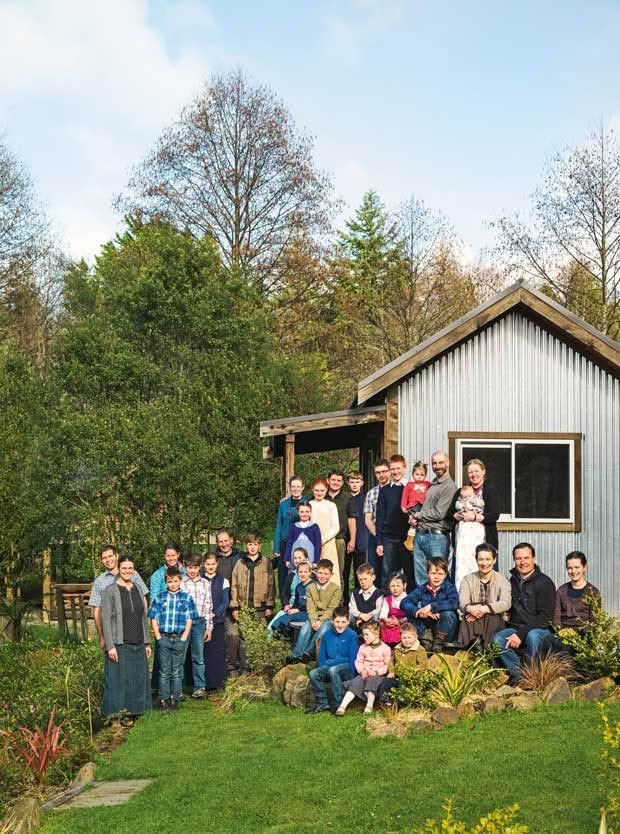
The community of 35 assemble outside one of their tiny homes.
Driven by a vision of a simpler way, five Manawatu families are reaping the benefits of living side by side.
Words: Lucy Corry Photos: Jane Ussher
Jared and Tressa Wayman had a good life. They lived in a sought-after region close to family and friends; they had three healthy children, a pleasant home and satisfying work. But somehow, it wasn’t quite enough. “We had great lives on paper, but we had a hope welling up in us for something better,” Jared says.
“Up to that point we had taken a more individualistic approach to success, yet we felt a growing desire to live life in a deeper relationship with those of a like mind, emphasizing values of love, care and cooperation, in a sustainable environment. “It wasn’t a mid-life crisis; we just started considering the path we were on and where it was leading to.”
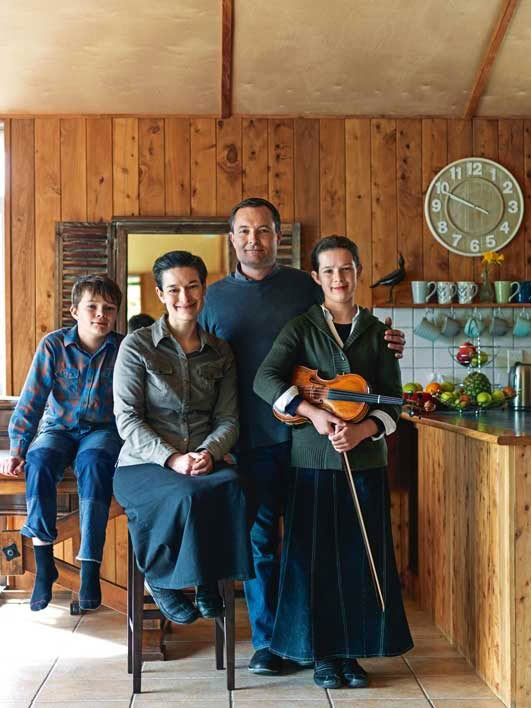
Jared and Tressa Wayman with two of their three children, Boone and Annaliese. Their oldest son, Tate, is currently living with an intentional community (people who’ve chosen to live together according to a common purpose) in Texas.
Now, if you come across them going about their lives in deeply rural Kimbolton, near Feilding, you can see that they’re working towards a level of peace and satisfaction for which they once only hoped. They say the fact that they’re sharing their lives with four other families is a dream come true. “What we’re doing here is not for the faint of heart, but we are all encouraging each other,” Jared says. “We’re not perfect, we see how short we can fall of our ideals. But we are very thankful for what we have – and we are continuing to change and grow together.”
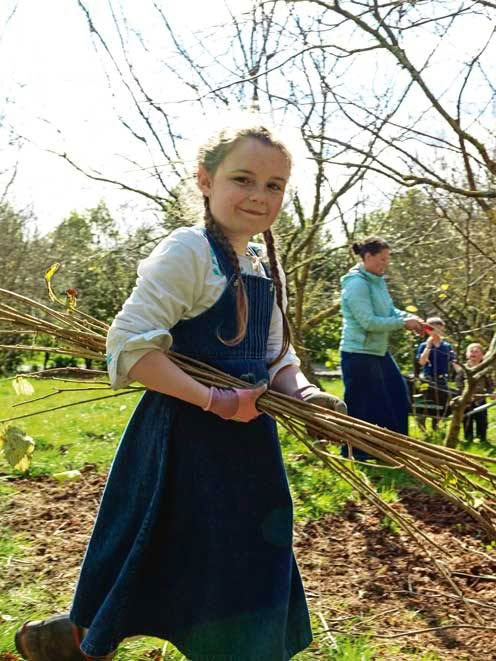
Christiana Rimmer works in a team pruning hazelnut trees.
The families describe themselves as an “intentional Christian community” who are finding greater fulfilment through participating in a life of cooperation, sustainability and simplicity. They haven’t chosen to drop out of mainstream society, but to live in a way that more closely reflects their shared values and ideals. Each lives in their own house and takes responsibility for their finances and the home-schooling of their children, though they share skills to make the most of each other’s strengths. “Community means common unity,” Jared says. “We are learning to lay down a level of our independence and self-assurance so together we can raise our families and run our businesses in a way that reflects our common purpose. We hope that the life we live together can, in turn, make a positive contribution to the lives of our friends and neighbours around us.”
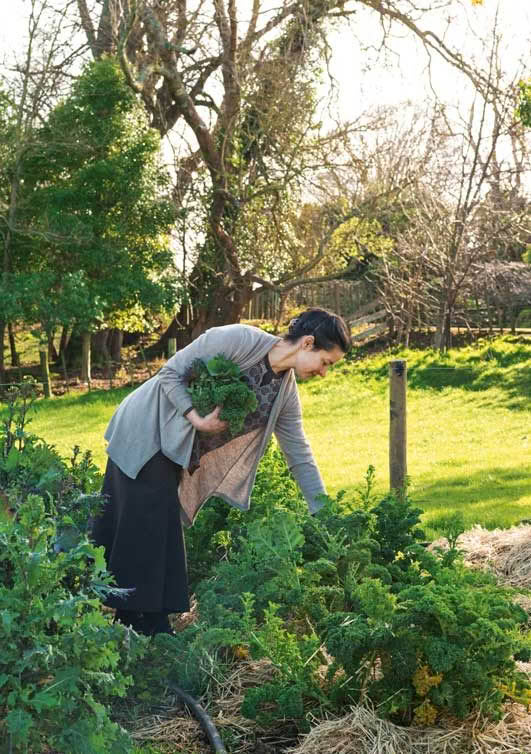
Tressa Wayman.
The story of how they got to this point begins about a decade ago, when they were living in Mapua near Nelson and Jared was working in his family’s long-standing construction business. Deciding to home-school their oldest son Tate, who was struggling with learning difficulties, made them examine their lives more carefully.
“We couldn’t change one area of our lives without it changing all the others,” Jared adds. “The entire context of our lives started to come into question for us, and we thought, ‘is there something better? How do we move forward into a better way to spend our time, raise our children and earn our money?’”
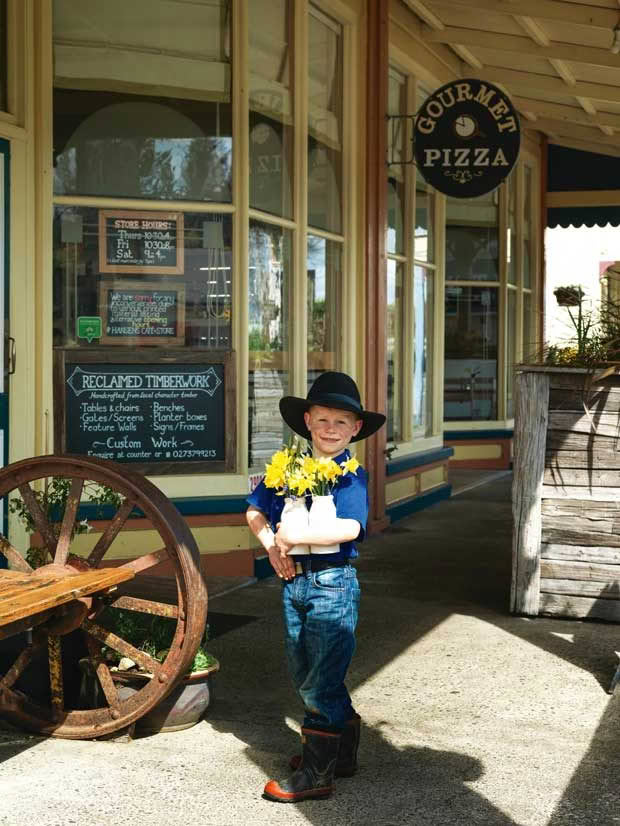
Josiah Crozier, with an armful of daffodils for Hansen’s Café and Store. The revitalized café is open Thursday to Saturday.
Gradually, they started to meet other families who shared their views. The Waymans met Ralph and Fleur Lattimore through mutual friends, while Eddie and Rachel Rimmer belonged to their church. South Africans Peter and Tammy Macfarlane were enfolded into the group after moving up from Southland and joining the church too, while the connection with Rob and Jo Crozier came through the home-schooling network. As they got to know each other better, a sense of momentum started to build.
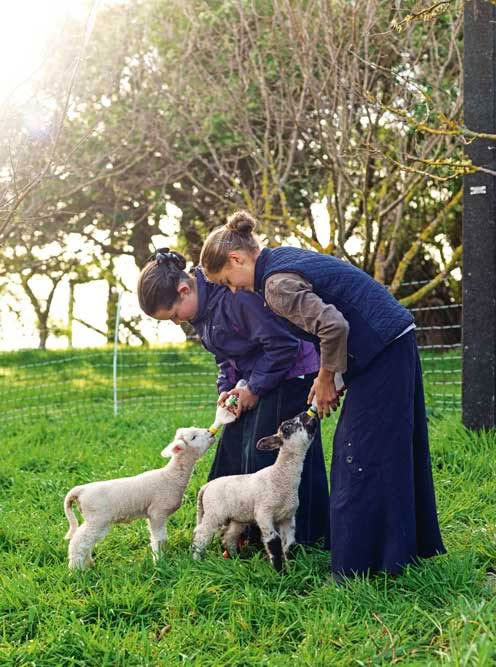
Annaliese and Zara Lattimore feed orphan lambs.
“All of a sudden it felt like there was some substance to the things we were talking about,” Jared says. “We had this developing sense of unity, so we didn’t want to make a blunder. We had read lots of books and heard of lots of other communities, but nothing spoke to us. We wrestled with the logistics and how to start for a long time.”
Tressa laughs as she recalls some particular specific concerns of her own: “When we first started learning about intentional communities a long time ago I said to Jared, ‘I just have to tell you, I cannot share my kitchen and I’m not living in a dormitory.’”
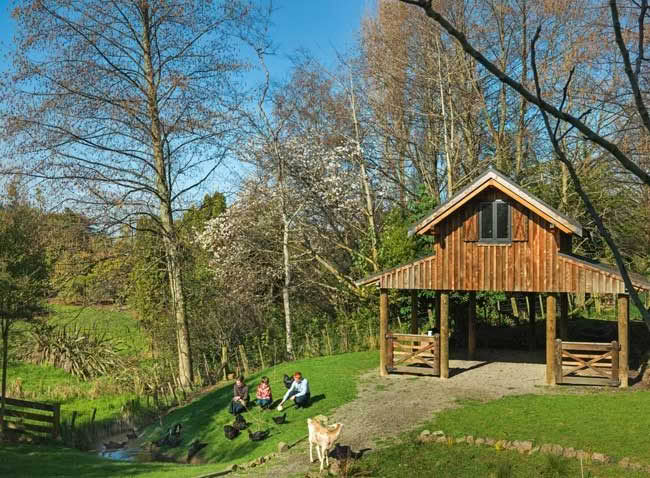
Annaliese and Boone Wayman feed the ducks and chickens with Benjamin Crozier.
One of many turning points came when the families met members of an American intentional Christian community that seemed to share similar goals. “Seeing people further along the path resonated with us,” Jared says. “We saw something there that we really liked and we realized there was a lot more to it.” The families knew they wanted to live rurally, but they knew they wouldn’t be able to afford to make the dream a reality in Mapua. Showing tremendous trust in each other and the greater good, they began selling their homes and businesses, preparing themselves to move even though they didn’t know where they were going to end up.
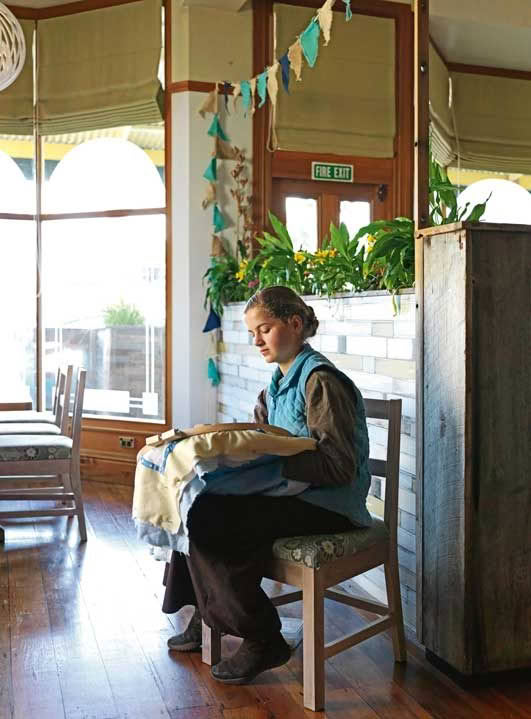
Zara Lattimore quilts a baby blanket.
“We also knew that we could spend a lot of time considering and being wistful and hopeful of things, but until we applied ourselves and took a step, nothing was going to change,” Jared says. They started looking for a property that would fulfil their collective wish list – somewhere affordable where they could be involved in the rural fabric of life and have public-facing businesses.
Jared had gone to check out a Kaikoura lavender farm in Easter 2015 when Tressa rang to tell him that she’d seen a property for sale near Feilding. Tressa, who came to New Zealand from South Carolina as a Rotary Exchange scholar in the early 1990s, didn’t know where Feilding was but the low property prices piqued her interest. Less than a week later, three of the men flew up to check out the area.
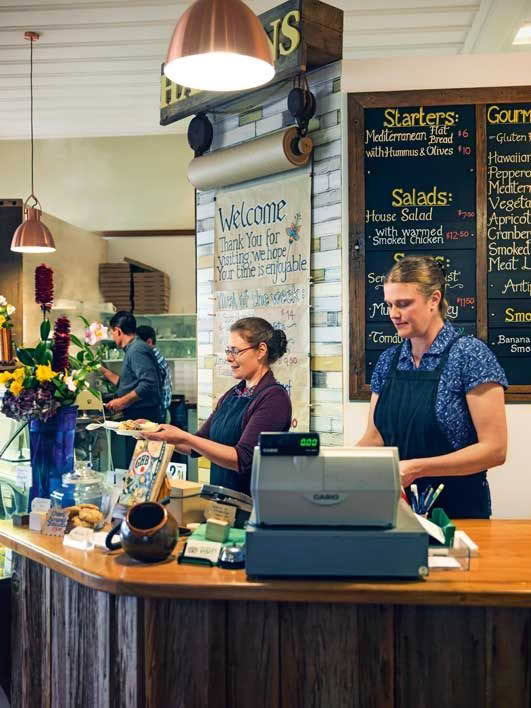
Rachel Rimmer and Tammy Macfarlane serve in the café.
“Eddie had spotted that the café in Kimbolton was for sale, so we came up in a hurry,” Jared says. “Everything in the town seemed well-kept and well-cared for, and we thought, ‘there’s something to this place’. “The café was a beautiful blank canvas, right in the middle of town. At that point we really didn’t know what we were going to do but we felt really good about it.”
Less than a month later they had bought the café property, which included a house and a barn, and 2.5 acres nearby. Most of the families moved up by June 2015, increasing Kimbolton’s population by more than 10 per cent. “We were quite the spectacle, I think, but we felt very welcome,” Tressa says. Revitalizing the café, which had been the village’s general store for nearly a century, was the priority. “We probably made 500 decisions in that month of renovation,” Jared says. “We didn’t sit around in a committee, we were moving with a purpose, and we had to get stuff done, so we got on with things. We learned a lot in that time, especially about how to hear other’s perspectives on renovation ideas and not be offended.”
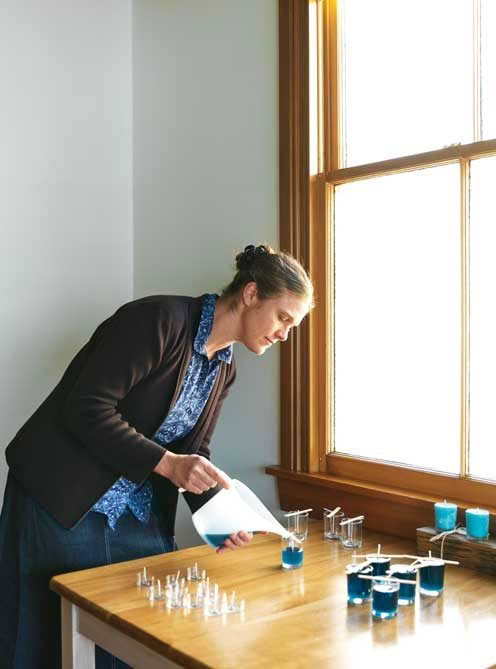
Tammy Macfarlane pours soy candles.
Now, after two years, their hard work is bearing fruit. Hansen’s Café & Store (named after the first owners of the general store) is a thriving business, attracting out-of-towners and locals alike. It’s also living proof of how the families have pooled their considerable skills and talents, despite none of them having any experience in the hospitality industry. Fleur Lattimore and Tammy Macfarlane redesigned the interior while their husbands, Ralph and Peter, handcrafted all the heritage timber accents that give the café its distinctive look. Eddie and Rachel wrote, performed and recorded the music that plays over the sound system, Fleur does the flowers and Tammy writes the menu in an elegant cursive script. Tressa manages much of the café’s administration and logistics, while Jared and Eddie look after front of house. It’s been a huge learning curve, Jared says.
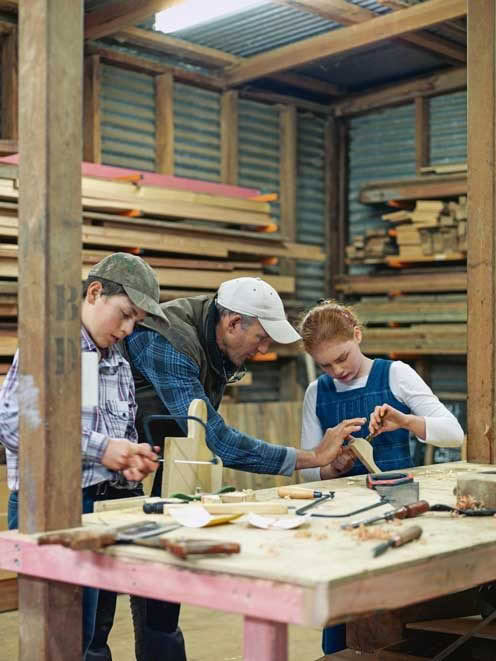
Ralph Lattimore helps Taliah Rimmer and his son Ari make wooden items for a craft fair.
“Eddie and I used to hide behind the wall when the door opened, and I’d push him out to serve,” Jared says. “Luckily, our customers were very gracious when we started and they were very kind to us when we made lots of coffee disasters. We had no hospitality experience, but our wives are very good cooks. We probably over-invested in the food, ambience and service because we wanted to make Hansen’s a place that we would like to come to and enjoy. We aren’t just waiters; we’re developing friendships with people who happen to be our customers.” The café also provides an outlet for the many crafts the families make, from soap and natural body-care products to bags made from recycled fabrics, handcrafted timber tables and soy candles.
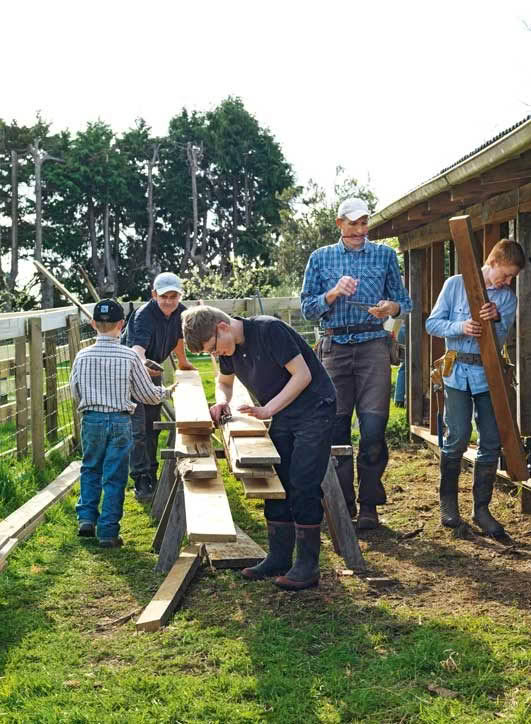
Eddie Rimmer and Ralph Lattimore work on a duck run with children Noah Crozier (in cap), Oscar Rimmer (middle) and Benjamin Crozier.
Across the road, the group’s other property is being used to showcase some of its larger projects. What used to be an unimpressive paddock is now an attractively landscaped area with neatly laid-out vegetable gardens and a series of structures that showcase the immaculate building work of Ralph and Peter. Ralph, a former Tall Blacks basketball player, has transferred his previous expertise in traditional post-and-beam building into some areas since moving to Kimbolton, as shown by the small American barn, post-and-beam gazebo and tiny house on this site.
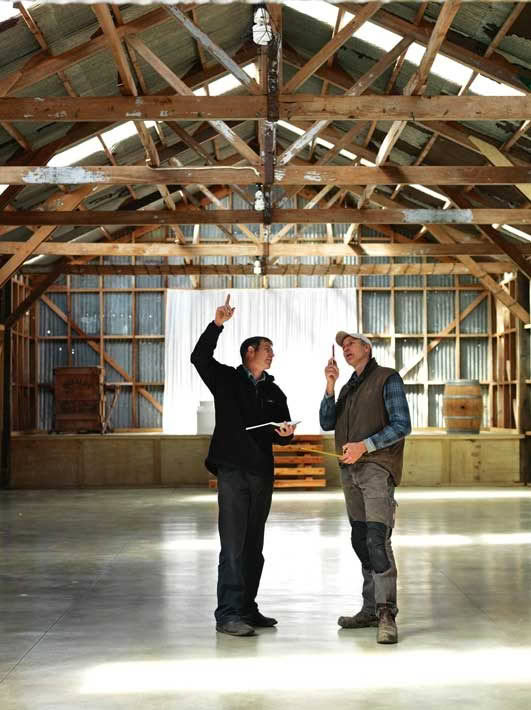
Peter Macfarlane and Ralph Lattimore inspect Heritage Timbercraft’s next job – enhancing an existing wedding venue with 200-year-old barn materials imported from the States.
Like much of what they’ve built together so far, this plot of land serves many purposes, Jared says. “We felt like we wanted to have a place where we could have outdoor get-togethers, but we didn’t realize how valuable this was going to be until we started doing it. Every plant, every rock was placed by adults and kids working together. It’s taken a lot of hard work to get this far though, and we’ve had lots of mucky days where things didn’t always go right. It’s not idyllic; it’s real life.”
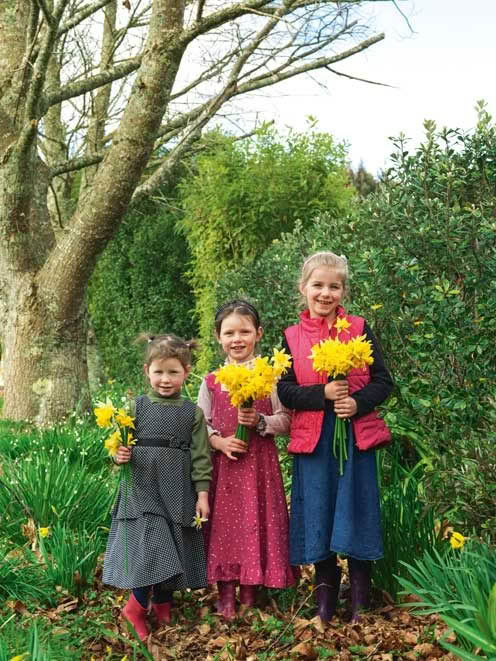
Hannah Crozier, Rebekah Crozier and Abigail Macfarlane gather daffodils.
In many ways, the members of this community are discovering the next steps as they go along, he says. They’re working hard together, bound by a common belief that they’ve chosen the right way of life. “We’ve all changed a lot. I think we see things more clearly together now, we’ve become more harmonious, and we have a level of cooperation that we didn’t have before. “It’s a bit like a marriage – there are no chains holding us together, but we have a growing confidence that this commitment towards a common unity is sustainable and is going to endure.”
HAPPY FAMILIES
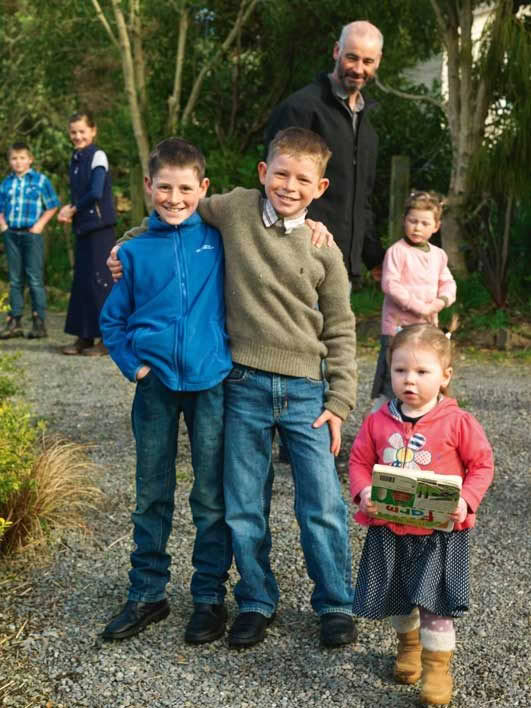
The children in this community are free from the bonds of screentime and digital devices. Instead, they have an inbuilt selection of ready playmates and no shortage of adults providing instruction on a variety of arts and crafts. Father-of-10 Rob Crozier with four of his brood – Isaiah, Noah, Saraiah and Hannah.
Four of the families have three children each, while Rob and Jo Crozier have recently welcomed number 10. Their eldest son, 17-year-old Daymon, is serving an apprenticeship with Heritage Timbercraft. The next oldest, Jared and Tressa Wayman’s son Tate, is currently visiting an intentional community in Texas learning a variety of skills including blacksmithing, wood turning and piano restoration. “We would have achieved very little in the past two years without the kids,” Ralph Lattimore says. “Honestly, they have been amazing.”
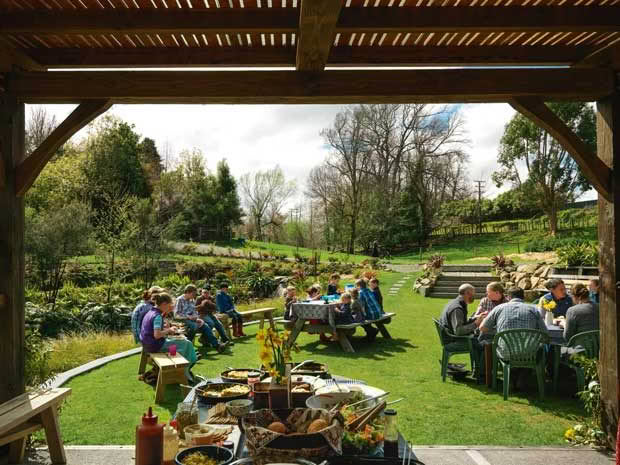
Ralph Lattimore helps Taliah Rimmer and his son Ari make wooden items for a craft fair.
Ralph says the couples can all see a positive difference in the children. “Having fewer distractions and less technology around, and being able to work more with mum and dad, or other adults, is good for them. I think the environment we grow up in shapes our behaviour and, here, there are opportunities for them to do something meaningful. That resonates with a lot of the farming families around here because that’s how it operates for them too.” Fleur Lattimore, a former international multi-sport athlete, says living a quieter (but no less busy) life has changed how they feel as parents. “I think you’re more present with your kids; you notice things because you’re enjoying where you are rather than needing a distraction to feel peaceful. Every year, I see how much more the children notice.”
HISTORY IN THE MAKING

The café has become a focal point for the families, not least as a place to show off the many handcrafts they make with their children.
Much of the distinctive look of Hansen’s Café & Store is due to Peter Macfarlane and Ralph Lattimore’s handiwork. The pair can see the beauty and potential in weathered totara fence battens, power pole cross-arms and other pieces of timber. Their business, Heritage Timbercraft (heritagetimbercraft.co.nz), combines Ralph’s background in large-scale construction with Peter’s eye for artistic detail. Their skills have already been in demand (they were recently involved in the reconstruction of a heritage American barn in outer Auckland that featured on Grand Designs), and they’re looking at ways to create pieces that can be easily shipped around the country. For example, the prototype tiny house they’ve designed and built (taking inspiration from Pinterest and YouTube) is fully transportable.
“I love the character, texture and the colours of all the heritage material we find and I love finding ways to bring it together to make something that’s got some beauty and timelessness,” Peter says. With the limited range of heritage material available in New Zealand, Peter and Ralph have sourced a container load of 200-year-old hand-hewn beams, threshing floor planks and barn cladding from the United States and Canada. “We know that people love the character and history of this timber and look forward to seeing how it might be used,” Peter says. “We want to stay busy making useful things that are also pieces of art.” hansenscafeandstore.co.nz
 This article first appeared in NZ Life & Leisure Magazine.
This article first appeared in NZ Life & Leisure Magazine.
